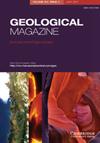Oceanic resurge deposits at the Rochechouart impact structure (France) suggest a marine target environment
IF 2
3区 地球科学
Q3 GEOSCIENCES, MULTIDISCIPLINARY
引用次数: 0
Abstract
Abstract The Rochechouart impact structure, located in the western part of the Massif Central in France, has been suggested to be one of the largest impact structures in western Europe. Various age datings have placed the event in a span from the Late Triassic to the Early Jurassic, but the most recent works favour a Late Triassic age. Very little is known about the target environment at the time and location of the impact event. Seemingly coeval, potential tsunamites along palaeoshorelines of the sea that covered parts of continental Europe at the time have been suggested to be related to the impact event and may indicate a marine target setting. Here we apply the method of visual line-logging of the graded suevite in the Chassenon SC2 drill core. This method has previously been used to investigate the depositional environment of similar deposits in several marine target impact craters. It allowed us to compare the deposits at these craters with those at Rochechouart, and in this way not only confirm the marine target setting, but also estimate the target water depth to be ∼200 m. Altogether, our results indicate a palaeogeographic target setting in a newly opened seaway connecting the Paris Basin with the Aquitaine Basin, which may indicate an age of impact at the younger end of the hitherto suggested age-span, i.e. in the late Rhaetian – Early Jurassic.Rochechouart撞击构造(法国)的海洋复活沉积物表明存在海洋目标环境
摘要Rochechouart撞击结构位于法国中部地块的西部,被认为是西欧最大的撞击结构之一。各种年龄定年法将该事件的时间跨度从三叠纪晚期到侏罗纪早期,但最新的研究结果倾向于三叠纪晚期。对撞击事件发生时的目标环境知之甚少。当时覆盖欧洲大陆部分地区的海洋古海岸线沿线的潜在海啸似乎与撞击事件有关,可能表明存在海洋目标。在Chassenon SC2岩心中,我们应用了分级苏铁的视线测井方法。该方法以前曾用于研究几个海洋目标撞击坑中类似沉积物的沉积环境。它使我们能够将这些陨石坑的沉积物与Rochechouart的沉积物进行比较,这样不仅确认了海洋目标设置,而且估计了目标水深为~200米。总之,我们的结果表明,古地理目标设置在连接巴黎盆地和阿基坦盆地的新开辟的海道中,这可能表明撞击年龄在迄今为止提出的年龄跨度的较年轻一端,即在雷蒂阶晚期-侏罗纪早期。
本文章由计算机程序翻译,如有差异,请以英文原文为准。
求助全文
约1分钟内获得全文
求助全文
来源期刊

Geological Magazine
地学-地球科学综合
CiteScore
4.70
自引率
0.00%
发文量
111
审稿时长
3 months
期刊介绍:
Geological Magazine, established in 1864, is one of the oldest and best-known periodicals in earth sciences. It publishes original scientific papers covering the complete spectrum of geological topics, with high quality illustrations. Its worldwide circulation and high production values, combined with Rapid Communications and Book Review sections keep the journal at the forefront of the field.
This journal is included in the Cambridge Journals open access initiative, Cambridge Open Option.
 求助内容:
求助内容: 应助结果提醒方式:
应助结果提醒方式:


